Rome, Via Aurelia, April 11, 1955: The Vicar of Rome, Cardinal Clemente Micara, blesses the foundation stone of the Church of Our Lady of Guadalupe and Saint Philip Martyr.
The Legion in the Service of the Church


Rome, Via Aurelia, 1958: Concluding moment of the construction work of the Church of Our Lady of Guadalupe and Saint Philip Martyr.
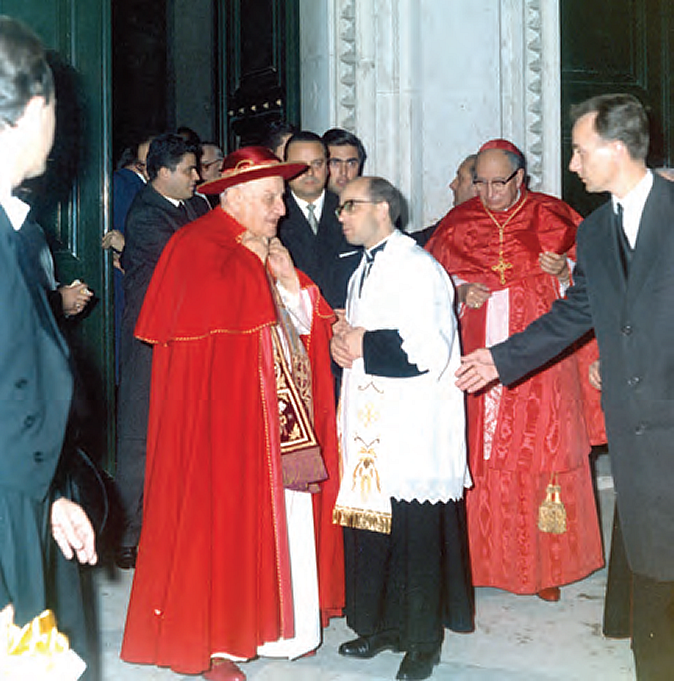
Rome, Parish of Our Lady of Guadalupe and Saint Philip Martyr, November 20, 1962: Saint John XXIII greets the newly appointed parish priest, Fr. Antonio Lagoa, LC, during his visit to the Mexican National Church.
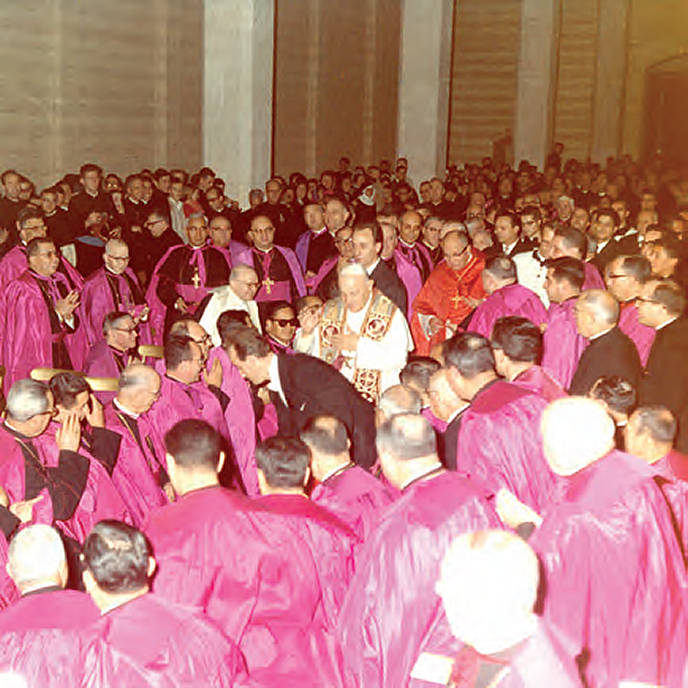
Rome, Parish of Our Lady of Guadalupe and Saint Philip Martyr, November 20, 1962: Saint John XXIII enters the Mexican National Church surrounded by Latin American bishops.
December 11, 1958
Parish of Our Lady of Guadalupe and Saint Philip Martyr
Starting in 1952, the Congregation was legally dependent on the Diocese of Rome. In the post-war years, the city of Rome experienced a phase of rapid demographic growth and swift urbanization, which posed serious pastoral challenges.
In a speech to the parish priests of Rome on March 8, 1952, Pope Pius XII expressed his apostolic concern for the state of his diocese:
“It is enough to take a look at the concrete state of the care of souls to recognize that it still does not fully correspond to present needs. […] We have the duty to think about what still remains to be done […] The city of Rome has grown in territory and in population at such a rapid pace that the ecclesiastical organization has not been able to keep up. […] This state of affairs compels us to accelerate and increase as much as possible the foundation of new parishes and the construction of new churches.”
In the following years, dozens of new religious centers emerged throughout the outskirts of Rome. Among them was a new temple in the Aurelia area. This construction was entrusted to the Legion of Christ by Cardinal Clemente Micara, Vicar of the Diocese of Rome.
This temple was intended to become the national church of Mexico in Rome, dedicated to the Virgin of Guadalupe, patroness of Mexico and Latin America, and to Saint Philip Martyr. On April 3, 1955, Pope Pius XII personally blessed the foundation stone, which had been brought to Rome directly from Tepeyac Hill, where the Virgin appeared in Mexico. Construction began shortly thereafter. The Mexican people provided the financial means to carry it out, contributing generous donations.
The work lasted nearly three years. The inauguration was originally scheduled for October 12, 1958, but had to be postponed due to the death of the pontiff. That day, only a private Mass was celebrated. Monsignor José Garibi Rivera, who just days later became the first Mexican cardinal, consecrated the temple on December 11, 1958, and the following day, the official inauguration took place. The event was attended by numerous ecclesiastical figures of the time and was presided over by Cardinal Micara, who, in addition to being the Vicar of Rome, was the president of the Pontifical Work for the Preservation of the Faith and the Provision of New Churches in Rome.
Under his leadership, 118 parishes were inaugurated between 1951 and 1965. He was known as “the visitor” because he always personally placed the foundation stone, inaugurated the temple, and presided over the installation of the parish priest. He did the same with the church on Via Aurelia: Cardinal Micara laid the foundation stone on April 11, 1955, presided over its inauguration on December 12, 1958, and, once it was canonically established as a parish, appointed the first parish priest, Legionary priest Antonio Lagoa, LC, on September 22, 1960.
On November 20, 1962, Cardinal José Garibi Rivera crowned the image of Our Lady of Guadalupe that stands above the main altar. That same day, Saint John XXIII went to pray before the image of the patroness of Mexico and Latin America. It was a significant visit, as it took place in the presence of many Mexican and Latin American bishops who were in Rome for the first session of the Second Vatican Council.
For his part, Saint John Paul II made a pastoral visit to the parish on January 27, 1980, on the occasion of the first anniversary of his first apostolic journey to Mexico. He had already known the church since 1970 when, as Archbishop of Krakow, he visited it during a pilgrimage of Polish priests. In his homily, the Pope emphasized the spiritual significance of the church:
“Your parish, dedicated to Our Lady of Guadalupe, is like a living testimony of the bond that, here in Rome, at the heart of the Church, we wish to keep alive with the Church of the distant American continent, gathered around the Mother. […] This Heart that unites all peoples and continents must also constantly unite you in your families, in your workplaces, in teaching, and in moments of rest. Through this parish, may it unite you with the Church in which Christ, Son of God and Son of Mary, lives and acts through His Spirit.”
On January 15, 1991, the same John Paul II granted the church the title of Minor Basilica. To this day, two Mexican ecclesiastics, both Archbishops of Guadalajara, have held the title of Cardinal Priests of Our Lady of Guadalupe and Saint Philip Martyr on Via Aurelia: from 1991 to 1993, Cardinal Juan Jesús Posadas Ocampo, and from 1994 to the present, Cardinal Juan Sandoval Iñiguez.
1960s and 1970s
Sending of priests
to Latin America
In the 1950s, the Church increasingly focused on the Catholics of Latin America. In the apostolic letter Ad ecclesiam Christi of 1955, Pope Pius XII outlined a work program to address the problems in that region, which was experiencing rapid and impressive population growth. The faithful represented about a quarter of all Catholics in the world, but there was a great shortage of priests. Latin America needed new vocations and the help of priests from Europe and North America. In fact, the lack of priests exposed the faithful to secularization and the influence of sects.
Pope Pius XII himself established two organizations to coordinate efforts: the Latin American Episcopal Conference (CELAM) in 1955 and the Pontifical Commission for Latin America in 1958.
To meet this challenge and form and send priests to Latin America, the Legion of Christ intensified its vocational work in Mexico and Spain while also sending religious to recruit vocations in Ireland, where a novitiate was established in 1962, and in the United States, where one was founded in 1965. Additionally, on December 19, 1960, Pope John XXIII sent a special blessing to the Legion: “We send our paternal blessing to the generous youth who wish to follow the priestly vocation in the Legion of Christ to work for the Holy Church and the souls in Latin America.”
From 1962 to 1965, the Second Vatican Council took place, and during the four sessions, the majority of the Mexican bishops who attended the works in Rome stayed at the General House of the Legion of Christ on Via Aurelia. This cohabitation was a sign of eloquent ecclesial communion between the Mexican episcopate and the young Congregation, and it had fruitful results for the mission to be carried out.
On July 3, 1966, as part of this project, Pope Paul VI ordained a group of priests and deacons from Latin America at St. Peter’s Basilica. Among these priests were two Legionaries of Christ. In his homily, he spoke about the importance of the apostolate of priests among the Latin American population.
The result of the Congregation’s efforts was that between the 1960s and 1970s, nearly one hundred young Europeans and North Americans went to Mexico to spend a period of apostolate during their years of formation, working in various educational works that were being simultaneously founded. Once ordained as priests, many of them returned to these same works to occupy positions of responsibility.
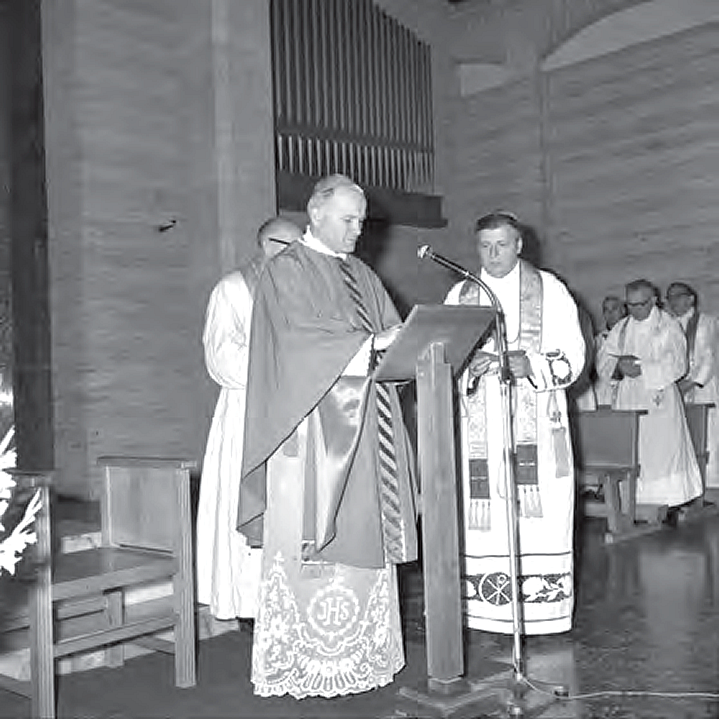
Rome, Parish of Our Lady of Guadalupe and Saint Philip Martyr, May 31, 1970: The Archbishop of Krakow, Cardinal Karol Wojtyła, during the Mass celebrated on the occasion of a pilgrimage of Polish priests in the Eternal City.
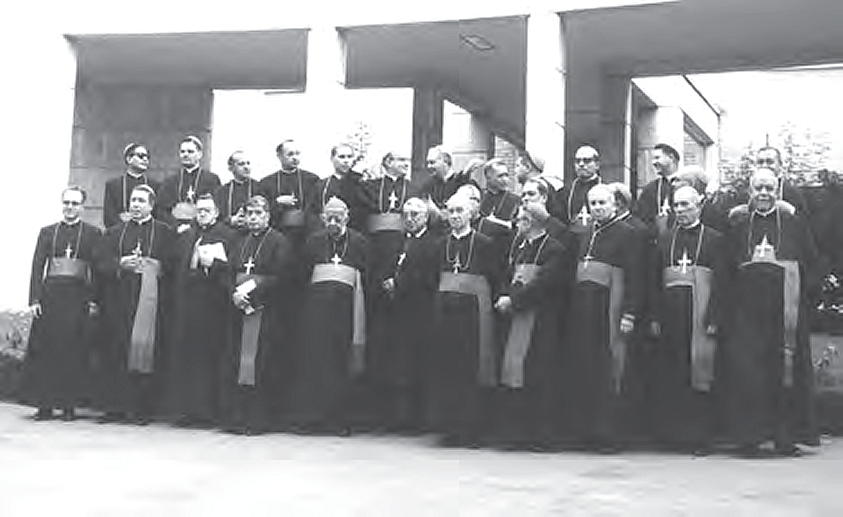
Rome, October 31, 1962: Group photo of the Mexican Bishops staying at the Collegium Maximum of the Legionaries of Christ on the occasion of the first session of the Second Vatican Council.
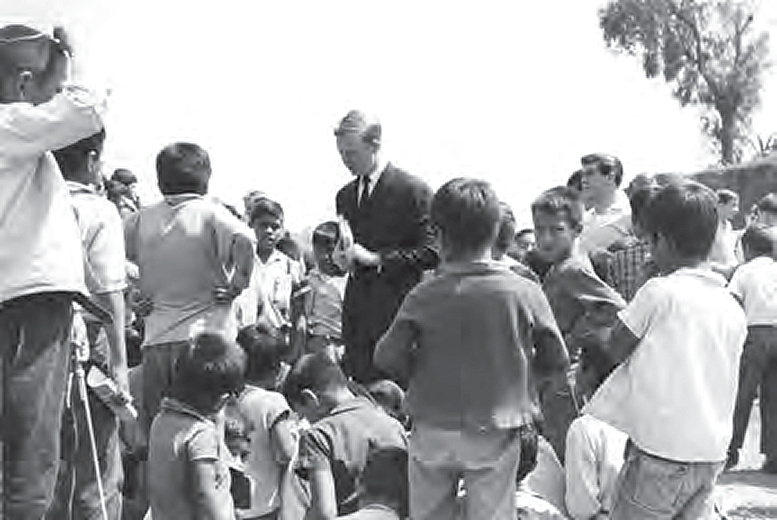
Mexico City, 1966: The young Legionary of Christ, John Walsh, LC, with some children from the Colegio Mano Amiga. He is one of the first Irishmen to develop his apostolate in Latin America.
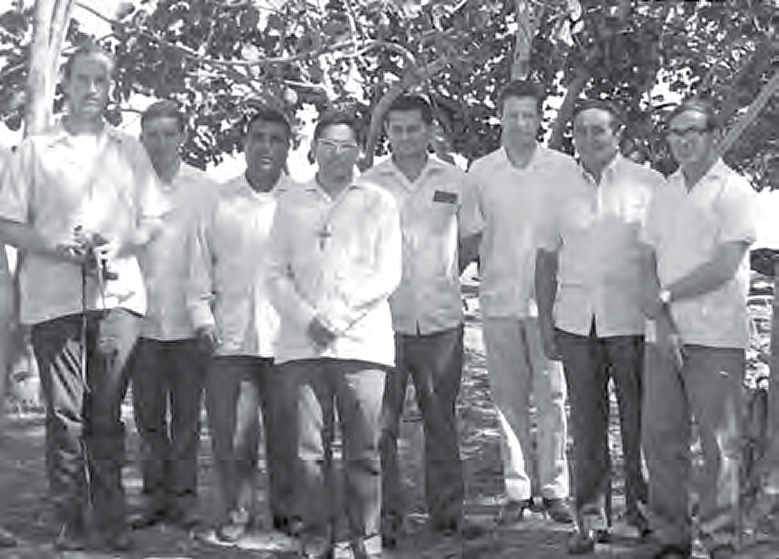
Prelature of Chetumal, early 1970s: Mons. Jorge Bernal, LC, with the first missionary priests working in the new ecclesiastical jurisdiction.
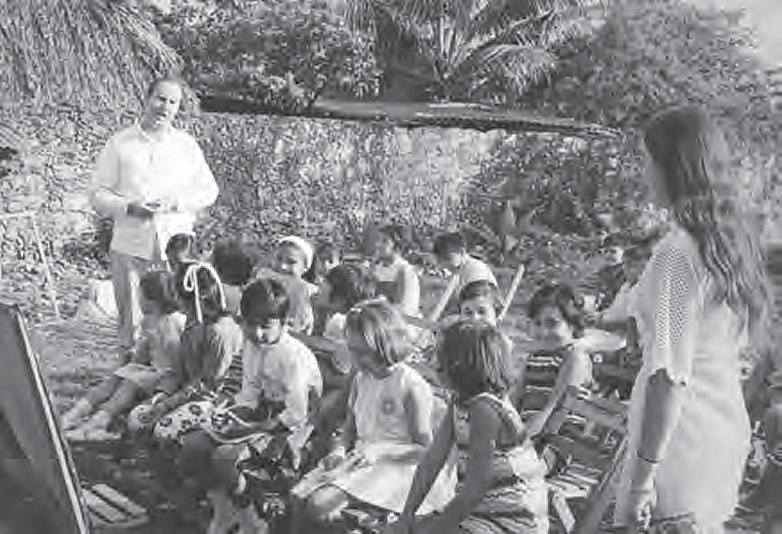
Prelature of Chetumal, early 1970s: Father John Coady, LC, during a catechism lesson with some children.
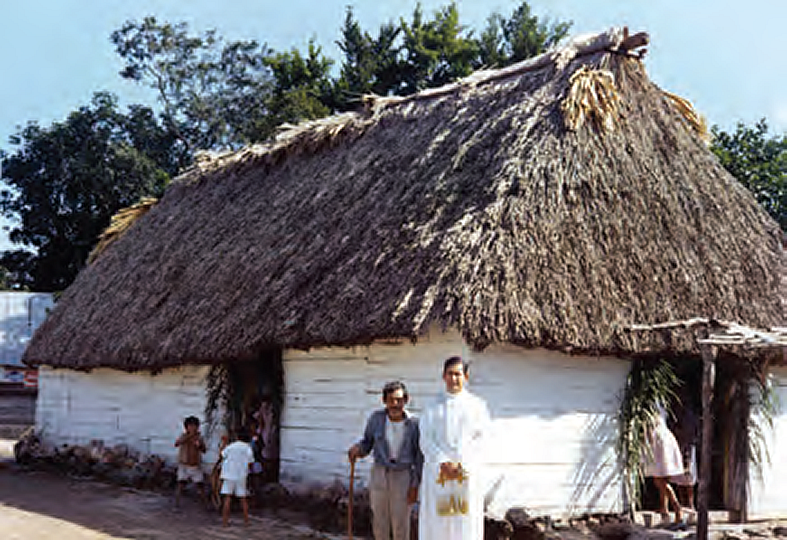
Prelature of Chetumal: Bacalar, 1973: Father Javier Orozco, LC, with some Mayan Indians.
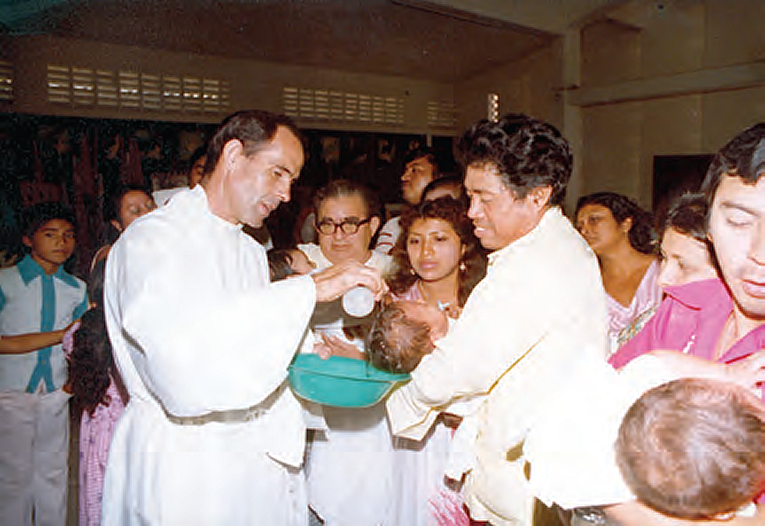
Prelature of Chetumal, Isla Mujeres, early 1980s: Father Ángel de la Torre, LC, administering the sacrament of baptism.
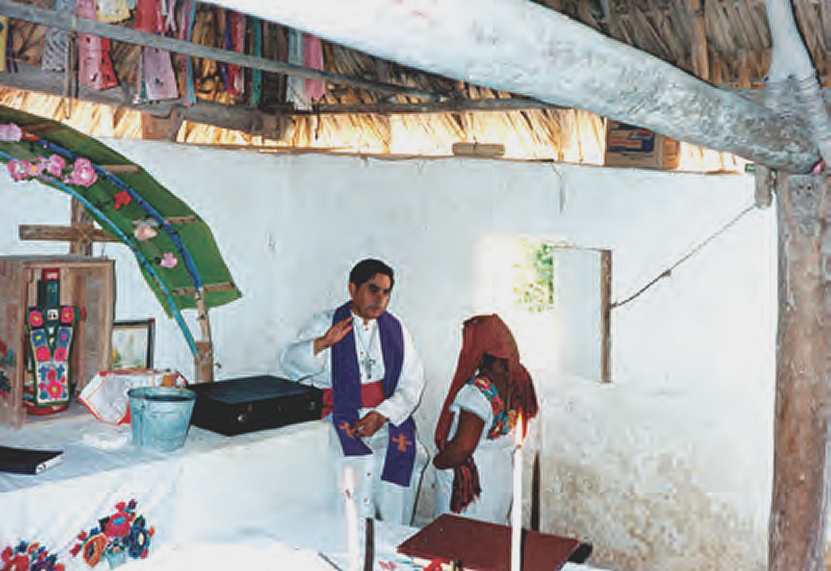
Prelature of Chetumal, 1980s: Mons. Jorge Bernal administering the sacrament of reconciliation.
July 16, 1970
Prelature of Cancún-Chetumal
A sign of the Holy See’s interest in Mexico was the creation of the Prelature of Chetumal, with the Apostolic Constitution Qui ad beati Pauli Apostoli similitudinem, promulgated by Pope Paul VI on May 23, 1970, and signed by Cardinal Carlo Confalonieri, Prefect of the Congregation for Bishops. The prelature was the result of the union of two areas previously separated from the Archdiocese of Yucatán and the Diocese of Campeche. It covered an area of 50,843 km², with only seven priests and a few religious sisters working to provide spiritual care to 88,000 inhabitants.
There were only seven churches and a series of chapels with wooden walls and palm leaf roofs. On July 16, 1970, Blessed Paul VI entrusted the new ecclesiastical entity to the Legion, appointing Legionary priest Jorge Bernal as Apostolic Administrator. He arrived in the prelature’s territory, along with several other Legionary priests, in November of that year.
The Legionaries of Christ encountered significant difficulties: the distances were vast, there were few communication routes, a large portion of the population was indigenous, spoke only the Mayan language, and many had not received the sacraments. This was a genuine mission of permanent evangelization. They quickly began constructing new churches and chapels in various parts of the region and tirelessly administered the sacraments of baptism, the Eucharist, and marriage tens of thousands of times.
On December 7, 1973, Paul VI appointed Father Jorge Bernal as titular bishop of Velefi (a title he retained until 1978) and Prelate of Chetumal. Monsignor Pío Gaspari, the Apostolic Delegate to Mexico, consecrated him as bishop on March 19, 1974. The following year, on June 28, Monsignor Jorge Bernal was appointed by the Holy See as a Consultant for a five-year term for the Pontifical Commission for Latin America. This commission’s mission is to study the fundamental issues of Catholic life in Latin America and collaborate closely with various national episcopal conferences.
In 1974, the Mexican authorities created the new state of Quintana Roo, which quickly became a major tourist area in Mexico. Today, around 7.5 million tourists visit each year, and there are nearly 800 hotels. This has brought tangible changes. For example, the city of Cancun, when the Legionaries arrived, was a small fishing village with 150 inhabitants, while today it has around 650,000 people.
This incredible population growth has occurred throughout the region: the 88,000 inhabitants of 1970 now total approximately 1.2 million, with around 950,000 of them being Catholic. Naturally, this rapid and impressive development has led to a significant increase in the number of priests dedicated to evangelization, which has had evident results. In 2010, there were 47 parishes in the territory of the prelature, 9 quasi-parishes, and 425 chapels.
On December 20, 1996, with the decree Nupera urbs from the Congregation for Bishops, the prelature’s seat was transferred from Chetumal to Cancun, and the prelature took on its current name, Cancún-Chetumal. In 2004, Monsignor Pedro Pablo Elizondo, LC, succeeded Monsignor Jorge Bernal as bishop of the prelature. In the book Una iglesia de corazón misionero. Libro de nuestra historia, published in 2010, Monsignor Pedro Pablo expressed his desire for the current mission of the diocesan community of Cancún-Chetumal with the following words:
“We need to renew and transform each parish into a home and school of communion, prayer, and mission, permanently offering courses in the Bible, Catechism, and Social Doctrine (…). Our main pastoral strategy should be the testimony of a holy life, dedicated without reserve, worn out in joyful and tireless service to our brothers and sisters.”
90s
The effort in priestly formation
Article 2 of the 1983 Constitutions stipulated that the Congregation could carry out works aimed at the care of diocesan priests. In 1985, the Centrum pro educatoribus seminariorum was established, with the express mission of working toward this goal. Additionally, in 1990, the Regina Apostolorum Academy was founded, which began organizing annual courses on the Church’s guidelines for priestly formation.
In 1990, the Vatican hosted the VIII General Assembly of Bishops, which, according to the intentions of Saint John Paul II, was tasked with deepening the topic of “priestly formation in current circumstances.” In the post-synodal apostolic exhortation Pastores dabo vobis, dated March 25, 1992, the pope explained the importance of the mission:
“The Church feels called to revive with renewed effort what the Master did with His apostles, as it feels compelled by the profound and rapid transformations of society and cultures of our time, as well as by the multiplicity and diversity of contexts in which it announces and bears witness to the Gospel, also by the favorable increase in priestly vocations in various dioceses around the world, by the urgency of a new verification of the contents and methods of priestly formation, by the concern of bishops and their communities due to the persistent shortage of clergy, and by the absolute need for the new evangelization to have priests as its first ‘new evangelizers.’”
Maria Mater Ecclesiae International College
The works of the Synod were the prelude to the birth of two important apostolic works of the Legion of Christ. On April 8, 1991, the Congregation for Catholic Education approved the foundation of the Maria Mater Ecclesiae International College, dedicated to the formation of diocesan formators. The introductory words of the decree of establishment, signed by Cardinal Pio Laghi, coincided with the Holy Father’s intentions: “All pastors and the faithful are firmly persuaded that the future of evangelization and universal Christian life largely depends on good priestly formation.”
Pontifical Athenaeum Regina Apostolorum (1993)
In fact, many bishops, especially from Latin America, had previously expressed the need for a college in Rome where they could send their seminarians destined to be rectors, formators, or spiritual directors, and the Legion of Christ offered to build it. Two years later, on March 25, 1993, the Congregation for Catholic Education also canonically erected the Pontifical Athenaeum Regina Apostolorum, an academic institution with faculties of theology and philosophy, which opened its doors with 350 students from 26 different nationalities.
Undoubtedly, the lived experience of teaching has helped the academic level of the Congregation as a whole grow and mature. As a culmination of this journey, Saint John Paul II appointed Father Francisco Mateos, LC, as a consultant for a five-year term with the Congregation for Catholic Education.
In the subsequent years, the Pontifical Athenaeum Regina Apostolorum has continued its process of institutionalization, achieving the final approval of its General Statutes by the Congregation for Catholic Education.
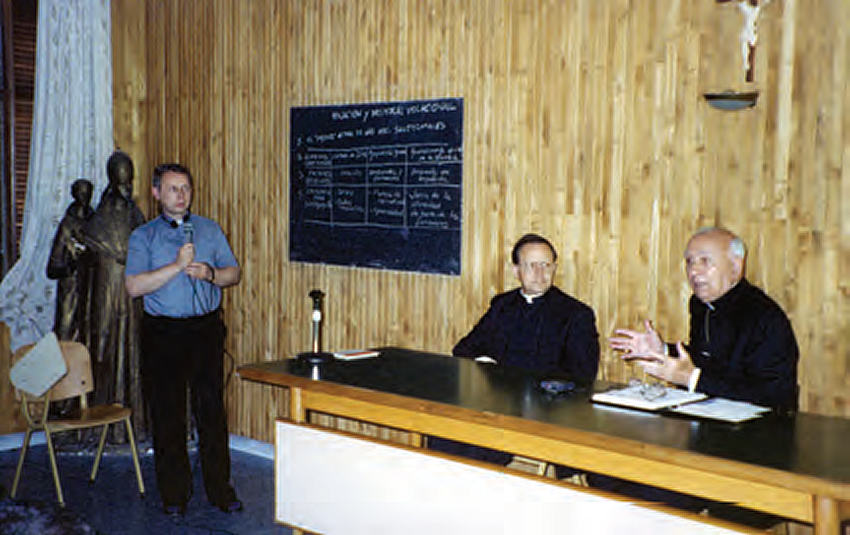
Italy, 1992: Father Francisco Mateos, LC, and Cardinal Pio Laghi during one of the first courses for diocesan seminarian formators organized by the Regina Apostolorum Academy.
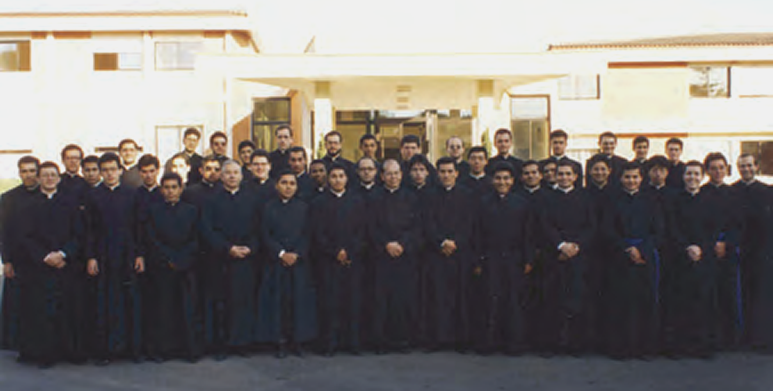
Rome, Castel di Guido, 1993: Group photo of the superiors and diocesan seminarians of the Maria Mater Ecclesiae International College.
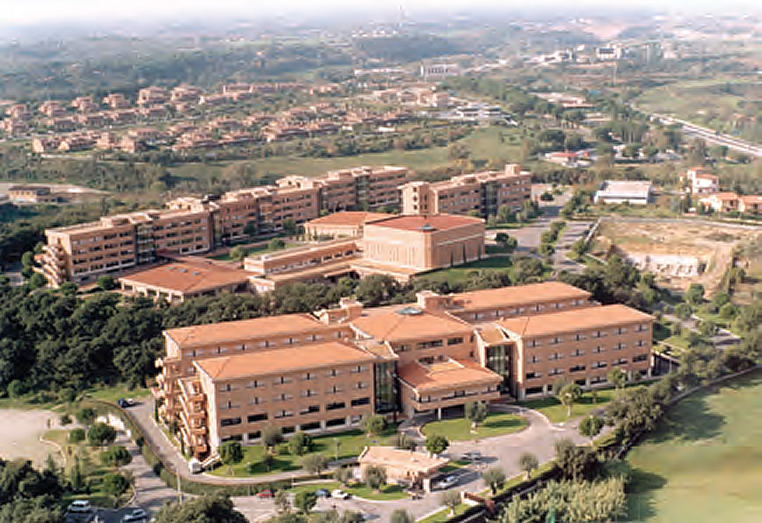
Rome, 1990s: In the foreground, the headquarters of the Pontifical Athenaeum Regina Apostolorum, with the Higher Studies Center, the College of the Legionaries of Christ in Rome, in the background.
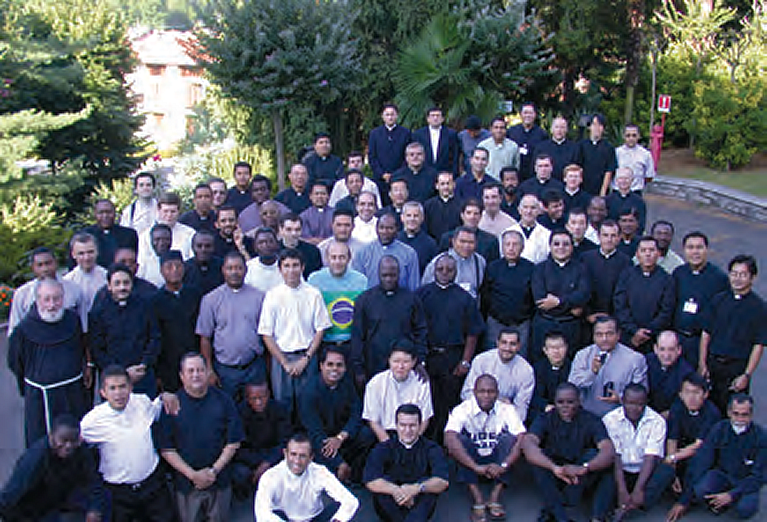
Italy, Leggiuno, July 2007: A group photo of the 82 priests from 40 different nations who participated in the 17th International Course for Seminary Formators.
This section has been taken from the publication «Historia Institucional de la Congregación de los Legionarios de Cristo y del Movimiento Regnum Christi» (2015), prepared by the General Historical Archive of the Legion of Christ and Regnum Christi and published on the occasion of the 75th anniversary of the Congregation.
Published originally in Spanish and Italian.
Texts: Salvatore Luciano Bonventre | Translations: Fr. Gonzalo Franco, LC | Selection of photographs: Salvatore Luciano Bonventre and Luigi Baldassarri | Coordination: Fr. Jaime Rodríguez, LC and Fr. Rodrigo Ramírez, LC


